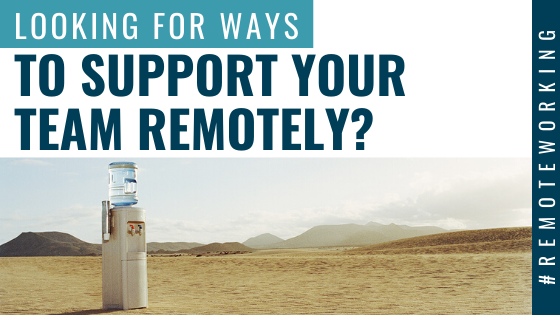We have a question for you. As many of us adjust to the new home office “status quo”…is anyone missing their team?! The meaningful conversations between meetings, the spontaneous one-on-one mentoring while grabbing a cup of coffee. What are you doing to help strengthen your bonds during this time? Here are some great strategies and tips from the Harvard Business Review on ways to Support your Team Remotely.
How Managers Can Support Remote Employees
- by Sabina Nawaz – April 01, 2020
In the global transition from corporate hallways to home offices, we’ve left something behind: meaningful access to managers. Gone are the instant answers to unblock progress, information streams that managers are privy to before the rest of the organization, informal feedback and coaching while walking together after a meeting, and predictable process and structures for communicating about work and ensuring mutual accountability.
Last week, during a coaching call, a senior director lamented, “I’m stalled because I don’t know how to connect with my manager on the less formal stuff — the way I used to.” He’s not alone. Manager distancing is frustrating employees and stalling work.
But managers are finding themselves struggling, too. For every employee who is trying to reach their manager, a manager is attempting to connect with half a dozen or more direct reports, plus trying to get direction from their own boss. In a poll of my coaching clients last week about their biggest challenges, their key themes were about how to stay connected with each team member, help manage their own and others’ stress, maintain team morale and motivation, run engaged meetings, track and communicate progress, and help their team shed nonessential work.
My coaching clients — managers in a variety of organizations — and I have worked through several scenarios and arrived at these six strategies to augment availability to employees when working remotely. We’re seeing early indications that implementing these strategies can reduce manager and employee stress, address concerns about employee work progress, increase productivity for them and their teams, and restore and maintain healthy communication channels.
Bridge distance through frequent connections.
Yuval*, CEO of a 1,000-person high-tech company, messages or calls his direct reports at least once a day, usually without a specific agenda. He says things like, “Checking to see if you need anything from me,” “What questions do you have for me today?” “Just learned about X and want you to be the first to know,” and “Thinking of you; reminded of our winter team outing and your killer s’mores as I look at the picture on my home office wall.” Instead of simply asking his direct reports to get in touch with him as needed, Yuval proactively manages the frequency of connection. This way, he always has a finger on the pulse of his team, especially those directs hesitant to reach out and add more to their boss’s plate during a crisis.
Blast through questions with office hours.
Managers make dozens of decisions daily and provide their people with scores of data points via informal conversations. These interactions don’t merit full meetings, but when they’re ignored, little things can languish and become looming problems. Marissa, executive director of a non-profit, has started holding office hours: an hour a day in which she invites her directs to join her on a video conferencing app if they have concerns that can be addressed in 10 minutes or less. When one person joins, she locks the meeting — the online version of shutting the office door. Everyone understands they should try back in about 10 minutes if a lock is in place. For more complex issues, Marissa asks her directs to schedule a dedicated meeting. Allocating time to deal with the flurry of daily issues maintains work fluidity and prevents small sore spots from festering into large pain points.
Provide stability through consistent rituals.
In lives riddled with unpredictability and constant change, rituals provide predictability and structure. While we don’t know what challenges we’ll face tomorrow, we do know there will be some. We can better manage the unpredictable by containing it within structured rituals whenever feasible. Here are some examples of how managers have ritualized their availability: 15-minute morning check-ins to regroup on overnight developments and establish a course for the day; opening a meeting by having everyone share one word to describe their current state of mind followed by an elaborative sentence (or saying “pass”); or a theme for each week’s meeting, such as everyone wears a hat. By creating a predictable ritual and leading by example, managers can foster a sense of connection, safety, and fun, even while their teams are buffeted by the forces of change.
Enhance safety through clear boundaries.
Expanding your availability as a manager can also have downsides. Some team members might not desire frequent connection as they continue to adjust to the new normal and wrestle with complex emotions. Others might want more time from you than your capacity allows. Be transparent about your availability plan, then set boundaries and invite others to do the same. You can say, for example, “I’m prioritizing my time with you. I’ll reach out in a variety of ways, from checking in with you daily to having office hours. Let me know if you need some space and don’t want to connect quite so frequently. I’ll also do my best to respond to your messages the same day. However, I’m taking advantage of this unique opportunity to reserve 30 minutes each day at noon to have lunch with my family.” By setting expectations and giving others space, we meet people where they are and give them permission to set their own boundaries.
Stay ahead of the game by inviting problems, not just solutions.
Our previous rules of engagement have gone by the wayside, so no one has definitive solutions. Invite your team to come to you with problems, even if they don’t yet have solutions. Consider saying, “In our current world, we all have questions, few people have answers. If you see signs of trouble, issues that aren’t visible to me, don’t wait to come to me until you have an accompanying solution. Bring me your early indicators and together we’ll devise experiments to tackle the challenge.” Explicitly signaling you want to know about budding problems will enable greater periscopic vision and access to broader sets of solutions.
Enable capacity through feedback.
The subtleties of nonverbal communication are lost in remote work, even with the video turned on. People’s need for recognition and good news is exacerbated in trying times. Reserve time at the end of each day to provide specific, positive feedback for good work (not just great work). Appreciation expressed can help smooth a lot of disruptive discomforts. Also provide timely corrective feedback before shortfalls aggravate your pile of problems. Small and frequent performance guidance circumvents major corrections down the road and allows everyone to stay in sync despite distance and daily change.
Researchers Teresa Amabile and Steven Kramer have extensively studied employee motivation and found that making progress in meaningful work is the key to keep employees engaged. While the swift shift to remote work can cause stress and many complications to daily activities, your job as a manager is to remove as many barriers to forward momentum as possible. By communicating a clear availability plan, you can help your team members feel better connected to you and address any concerns or questions as they arise.
Source: Harvard Business Review by Sabina Nawaz on April 01, 2020
Real full article: https://hbr.org/2020/04/how-managers-can-support-remote-employees
*All names and identifying information have been changed.
LOOKING FOR REAL ESTATE SUPPORT
Add us to your team.

